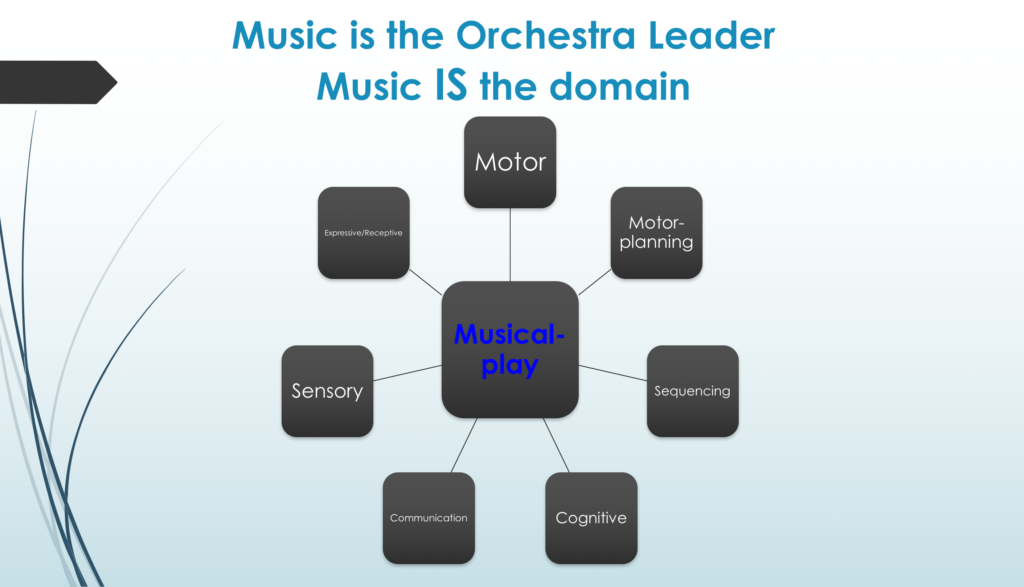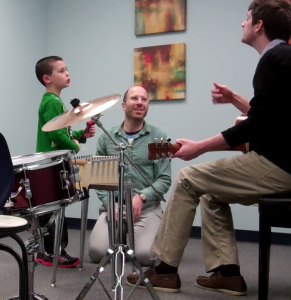This blog post includes some immediate and brief thoughts regarding the clinical rationale of back-and-forth relational music making between client and therapist. In addition, it touches on the importance of contextualizing music therapy experiences within a relationship-based framework, as well as emphasizing the significance of affective-based interactions.
Several moths ago I presented to a group of parents, therapists, and educators. During the talk I displayed a clinical video excerpt illustrating a continuous flow of co-active and related music making between the therapist and client. During the interaction, the client, an autistic 8 year-old boy who displays difficulty in sustaining self-regulation and with challenges in the area of sustained engagement and interaction, sits in his chair and musically participates with the therapist via social referencing and non-verbal, but tonal, vocalizations. The therapist, improvising a short melodic phrase (playing guitar and voice) pauses the music following the 3rd beat of the phrase. The client, referencing the therapist via a glance and a bewildered look on his face, follows the musical pause by glancing in the direction of the therapist on the 4th beat of the phrase. The therapist interprets the glance as a musical response and “turns the phrase around,”pausing after the 3rd beat. The client again references the therapist with a glance, but this time offers a smile accompanied by a tonal vocalization. The therapist alters the musical phrase by increasing tempo and articulating the melody vocally in a staccato manner. The client immediately recognizes the musical changes, leaves his chair and begins to pace by moving from wall to wall. His pacing is in tempo with the music as he attempts to visually track the therapist while vocalizing. The therapist shapes the melody and phrasing to provide a turn taking experience. The client follows and begins to consistently engage in a turn taking musical interaction. The therapist, recognizing the client’s ability to quickly perceive and express within the repeated musical frame, alters the music again by decreasing tempo and dynamics while modulating to the relative minor. The client waits, looks, anticipates and begins to find his place within the musical structure. He vocalizes and indicates an understanding in the change of melody and alters the melodic theme. The therapist follows the client’s musical lead and re-frames the harmonic content to join his newly formed melody. The client, continuing to crave movement, recognizes the musical change and re-directs his pacing towards the direction of the therapist who is providing a great deal of facial affect while offering a clear musical structure inviting the client. The client moves closer towards the therapist and strums the guitar with his right hand, smiles, and runs away in an excited and gratified manner. The music continues and develops momentum. The client comes back towards the therapist with anticipation while awaiting to find his musical place before strumming the guitar. He strums, smiles, and begins singing. The music reverts back to the original theme and a continuous flow of turn taking ensues before the child and therapist engage in spontaneous and simultaneous non-verbal relational singing.
Following the video, several audience members asked questions regarding the excerpt. Here is just a few of the questions:
Question: How is this musical-play helping the child develop learning and functional skills?
Response: Well, first, it’s important to understand the aim of the musical intervention, which is to provide experiences that will foster the client’s ability to musically: attend, regulate, engage, and become a purposeful two-way communicator. In short, this means providing musical experiences that will foster a continuous flow of back-and-forth musical communication. The key feature of musical communication is that the experience is contextualized in relational music making. Hence, the relationship, and learning through the experiences of relationship, is a core component of the work. Furthermore, the skills developed within the relational experiences of music making cross into conventional domains (i.e., sensory integration, self-regulation, socialization, expressive and receptive communication, etc.). We do not work towards developing these conventional domain areas in an isolated manner outside the context of relationship and affect (emotion). Thus, we work in music, with the client, within the context of relationship to deepen their experience IN music to foster a continuous flow of back-and-forth musicing. It is through the experience of relational music making in which the client develops and integrates conventional domain areas within the context of relating and communicating in music (and grounded in affect). In short, the clinical video excerpt illustrated some basic foundational capacities of social-emotional development such as self-regulation, attention, engagement, and purposeful communication via musical-play.
Question: Why are the capacities for attending, regulating, and engaging important when working with children with developmental challenges?
Response: The first step of any relationship process is being able to attend, listen, and take in the sights and sounds of the world in a calm and regulated manner. However, it’s not just about taking in the sights and sounds of the world for the sake of the sights and sounds. It’s more about taking in these sensory experiences and maintaining regulation and attention within the context of relationship to something and/or someone- intentionality (thinking, sensory-motor, and action are driven by affect). This in turn is how we learn how to relate and communicate to others though a wide range of emotional and sensory experiences. Where’s the functionality in developing attention and regulatory skills in an isolated manner in which these behaviors are not connected to affect or emotional experiences? Furthermore, how do we integrate these experiences if they are not grounded in affect or emotion? A major problem of learning skills in an isolated and non-contextualized manner is that the behavior will rarely generalize into various contexts. Hence, learning is effective when contextualized in affective relationship-based experiences. During affective interactions, emotional process are activated that are expressed though language, motor, etc. In the case of music therapy, they are expressed in music. (These experiences are built into the experience of co-active relational music making)

Question: Why is it important to be affectively or emotionally connected to others?
Response: That’s a great question. The ability to respond and initiate affectively while being emotionally connected to others is the theoretical basis of a relationship-based music therapy approach. The emotional component is crucial in developing higher levels of thinking, relating, and communicating. Learning through interactive affective experiences has given all of us our first cognitive, motor, communicative, and social lesson. Simply think about your early relationships with mom, dad, and/or caregiver and all of the foundational social-emotional skills acquired while being held as an infant (i.e., smiles, gestural cuing, glean in the eye, back-and-forth communication, etc.). These emotional relational experiences help to organize biological, social, and emotional processes. Children with developmental challenges, however, have difficulty engaging in these affective interactive experiences in a continuous manner because of their individual or biological differences i.e. sensory and motor planning challenges, hyper- hypo reactive, etc. that interfere with their ability to engage in sustained back-and-forth interactions. Thus, they are not experiencing essential emotional experiences that motivate and drive functional emotional development which leads to creating, bridging, and initiating ideas. Individuals who have difficulty creating ideas, answering “why” questions, and/or display challenges in grey area thinking simply repeat things. They are managing the work based on memory and repeating (i.e., perseverative behaviors, etc.). Therefore, the task of the music therapist is to support these biological differences in order to foster the child’s ability to be available for interaction while providing a range musical experiences that will foster a continuous flow of affective experiences, driven by back-and-forth relational communication. On the other side of the coin, typically, clinicians may be more concerned with teaching the child skills in an isolated manner (outside of relationship), such as teaching the child to sit (even though their nervous system is craving movement) or teaching a child to say “hi” to a random person without any emotional or relational context. The problem with teaching skills in an isolated manner, outside of a relational context, is that these behaviors will not generalize into other areas. In short, developing the ability to engage affectivity is extremely important and creates the path to learning within a relationship-based context. (These emotional and engagement processes are built into the experience of co-active music making)
Thanks for reading. I would love to hear you thoughts and ideas!
All the best,
John


Great post John. A question I typically get from parents and music therapy students is “why is affect such an important piece?” I have several reasons for this, most of which you already touched upon. But also, it’s important to meet (by meet I mean reflect the mood/emotion) the child’s affective presence. Commonly, in many contexts, the behavior is seen as something prohibiting further learning and regulation, however it is important that we do not extinguish what a child can offer us as a means of communication. This will lend itself to further engagement if we can tap into their means of communication. Once there, a therapist can offer, in context, a new affective experience within music, broadening the child’s gamut of relating. Ultimately, joining affect within the relationship can offer opportunities for reciprocity and interrelatedness.
Thanks for your comment, Mike! Affect is the key. Dr. Greenspan always said that affect is the conductor or the orchestra leader for all other domains. In other words, learning can only truly take place if it is guided and directed via affect. Being emotionally connected is very important to not only learning but also for generalizing learned skills across various settings.
Pingback:Teaching Behaviors in Music Making? Learning and Developing in Relational Musicing | Dr. John Carpente's Developmental Music Health Blog
Fantastic piece, John. Thank you for this.
I really appreciate this statement in your final response: “The problem with teaching skills in an isolated manner outside of context is that these behaviors will not generalize into other areas. In short, developing the ability to engage affectivity is extremely important and creates the path to learning within a relationship-based context.”
I would say that the kind of relationship-based, contextualized work that you do even goes beyond “generalizing” (a behavioral concept, that still doesn’t necessarily indicate intentionality). Relationship doesn’t only generalize, it personalizes–that is, it becomes something meaningful and adaptable on the level of person, not merely behavior. In this way, ways of relating in music become personally meaningful elsewhere–sometimes in ways that cannot even be characterized as “generalized skills/behaviors,” but as ways of being, that are meaningfully re-contextualized wherever they are needed. Just as would be the case for anyone, in life, but helped there via the special opportunities in the interactive, clinical musicking.
This is certainly no small thing. Thank you for doing it.
Hey Brian,
Thanks for your thoughts- always appreciated!
John
Brian,
I’m reading this in 2018, if you are able to connect with you please send me a email.
I would like to talk to you about your thoughts on “generalization”.
Michael Richardson – Music Therapist
michael.music.therapy@gmail.com